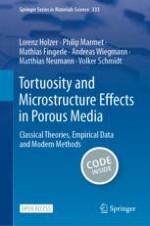This open access book presents a thorough look at tortuosity and microstructure effects in porous materials. The book delivers a comprehensive review of the subject, summarizing all key results in the field with respect to the underlying theories, empirical data available in the literature, modern methodologies and calculation approaches, and quantitative relationships between microscopic and macroscopic properties. It thoroughly discusses up to 20 different types of tortuosity and introduces a new classification scheme and nomenclature based on direct geometric tortuosities, indirect physics-based tortuosities, and mixed tortuosities (geometric and physics-based). The book also covers recent progress in 3D imaging and image modeling for studying novel aspects of tortuosity and associated transport properties in materials, while providing a comprehensive list of available software packages for practitioners in the community.
This book is a must-read for researchers and students in materials science and engineering interested in a deeper understanding of microstructure–property relationships in porous materials. For energy materials in particular, such as lithium-ion batteries, tortuosity is a key microstructural parameter that can greatly impact long-term material performance. Thus, the information laid out in this book will also greatly benefit researchers interested in computational modeling and design of next-generation materials, especially those for sustainability and energy applications.
